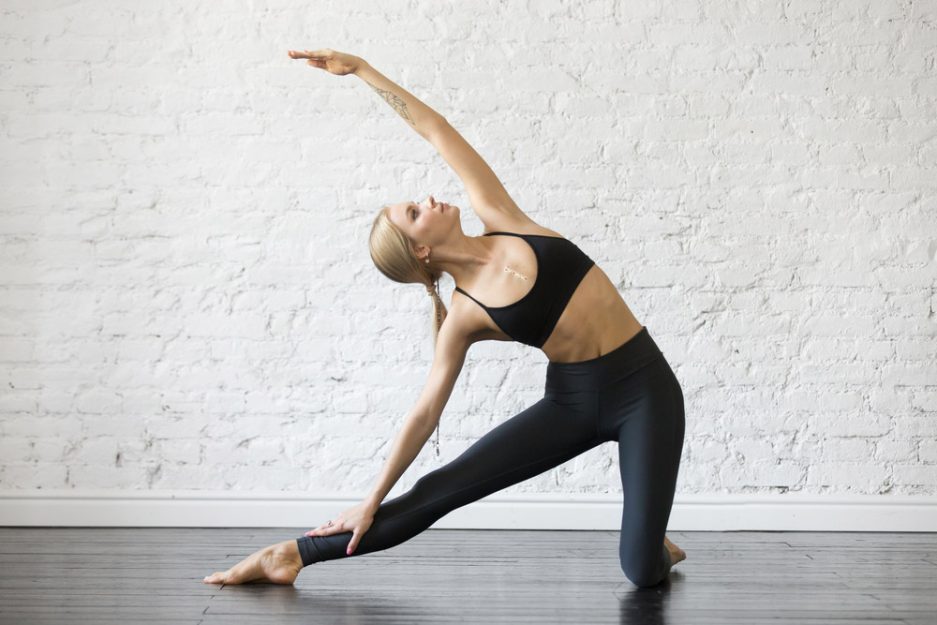Unlocking the Gate to Wellness: A Guide to Parighasana

Parighasana, also known as the Gate pose, is a yoga posture that is practiced to stretch and strengthen the sides of the body, open the hips, and improve overall flexibility. It is a standing asana that is suitable for practitioners of all levels and can be practiced as a warm-up before other poses or as part of a regular yoga practice.
In Sanskrit, “Parigha” means gate or beam, and “asana” means pose or posture. The name Parighasana refers to the shape of the pose, which resembles a gate or beam. The posture is also associated with the energy of the Manipura Chakra, located in the solar plexus, which governs self-confidence, willpower, and personal power.
Overall, Parighasana is a versatile and accessible yoga posture that can offer a range of physical and mental benefits to practitioners of all levels.
I. How to Perform Parighasana
To perform Parighasana, follow these step-by-step instructions:
- Begin in Tadasana (Mountain pose), standing at the top of your mat with your feet together and your arms at your sides.
- Step your left foot back about 3-4 feet, turning your left toes out slightly and keeping your right foot facing forward.
- Inhale and raise your arms out to the sides at shoulder height, palms facing down.
- Exhale and lean your torso to the right, reaching your right hand down toward your right ankle and extending your left arm up toward the ceiling.
- Keep your left leg engaged and your left foot firmly planted on the ground.
- Gaze up toward your left hand, or down toward your right hand if that feels more comfortable for your neck.
- Now hold the pose for several breaths, then release and repeat on the other side.
Tips for proper alignment and modifications:
- Keep both legs engaged and avoid locking the knees.
- Keep your torso lengthened and avoid collapsing into the side of the body that you’re stretching.
- If you have trouble reaching your ankle, you can place your hand on your shin instead, or use a block for support.
- If you have knee issues, you can modify the pose by bending your front knee slightly.
With practice, you can deepen your stretch and find more ease in the pose.
II. Benefits of Parighasana
Parighasana offers a range of physical, mental, and emotional benefits, including:
Physical benefits:
- Stretches and strengthens the hips, thighs, hamstrings, and spine
- Opens the chest and shoulders, improving posture
- Stimulates digestion and improves circulation
- Relieves tension in the neck, shoulders, and back
Mental and emotional benefits:
- Calms the mind and reduces stress and anxiety
- Increases mental focus and concentration
- Boosts self-confidence and self-esteem
- Helps cultivate a sense of inner peace and balance
Parighasana, or Gate Pose, offers a wide range of physical, mental, and emotional benefits that can enhance your overall well-being.
One of the most notable benefits of Parighasana is that it stretches and strengthens the hips, thighs, hamstrings, and spine. This can help improve your flexibility and mobility, as well as relieve tension in these areas of the body. By practicing Parighasana regularly, you can reduce your risk of injury and improve your overall physical performance.
In addition to its physical benefits, Parighasana can also offer significant mental and emotional benefits. The pose helps calm the mind and reduce stress and anxiety, making it a great choice for anyone looking to manage their mental health. Practicing Parighasana regularly can also help increase mental focus and concentration, boosting productivity and overall cognitive function.
Overall, the many benefits of Parighasana make it a valuable addition to any yoga practice. Whether you’re a beginner or an experienced yogi, practicing Parighasana regularly can help you improve your physical, mental, and emotional well-being.
III. Precautions and Contraindications
Although Parighasana is generally a safe pose for most practitioners, there are some precautions and contraindications to keep in mind:
- Avoid Parighasana if you have a knee, hip, or ankle injury.
- If you have low blood pressure, be cautious when coming out of the pose, as it can cause dizziness.
- If you have a neck injury or discomfort, keep your gaze down instead of up toward your hand.
- If you experience any pain or discomfort in the pose, come out of it and consult with a yoga teacher or healthcare provider.
Common mistakes to avoid:
- Collapsing into the side of the body that you’re stretching
- Locking the knees or hyperextending the front knee
- Holding the breath or breathing shallowly
- Overarching the lower back
And if you also want to learn different types of yoga asanas, then you can join the 300 hour yoga teacher training in Rishikesh.
IV. Variations and Advanced Poses
Variations of Parighasana for beginners and advanced practitioners include:
- Half Gate Pose: Instead of reaching down toward the ankle, place your hand on your thigh or hip for a more accessible stretch.
- Revolved Gate Pose: After coming into Parighasana, twist your torso and gaze toward the ceiling, opening the chest and shoulders even further.
Advanced poses that incorporate Parighasana include:
- Extended Side Angle Pose (Utthita Parsvakonasana): From Parighasana, bring your front hand down to the ground or a block and extend your back leg behind you, creating a deep stretch through the hips and legs.
- Revolved Triangle Pose (Parivrtta Trikonasana): From Extended Side Angle Pose, straighten your front leg and bring your back foot to meet the front foot, then twist your torso and reach your top arm toward the ceiling.
V. Conclusion
Parighasana, or Gate pose, is a versatile and accessible yoga posture that offers a range of physical, mental, and emotional benefits. By practicing this pose regularly, you can improve your flexibility, posture, and overall well-being. Remember to approach the pose with awareness and caution, avoiding any pain or discomfort, and modify or come out of the pose as needed. With dedication and practice, Parighasana can be a valuable addition to your yoga practice.
Parighasana is a great pose for anyone looking to improve their overall flexibility, posture, and well-being. Its accessibility makes it a great pose for beginners, while its variations and advanced poses offer a challenge for experienced practitioners. By practicing this pose regularly, you can stretch and strengthen your hips, thighs, hamstrings, and spine, while also opening the chest and shoulders, improving digestion, and reducing stress and anxiety.
It is important to approach the pose with awareness and caution, avoiding any pain or discomfort. If you have any injuries or conditions that may affect your ability to practice the pose safely, be sure to consult with a yoga teacher or healthcare provider before attempting it.
Overall, Parighasana is a valuable addition to any yoga practice and can help you cultivate a sense of inner peace and balance. So next time you’re on the mat, give Parighasana a try and experience its many benefits for yourself!




